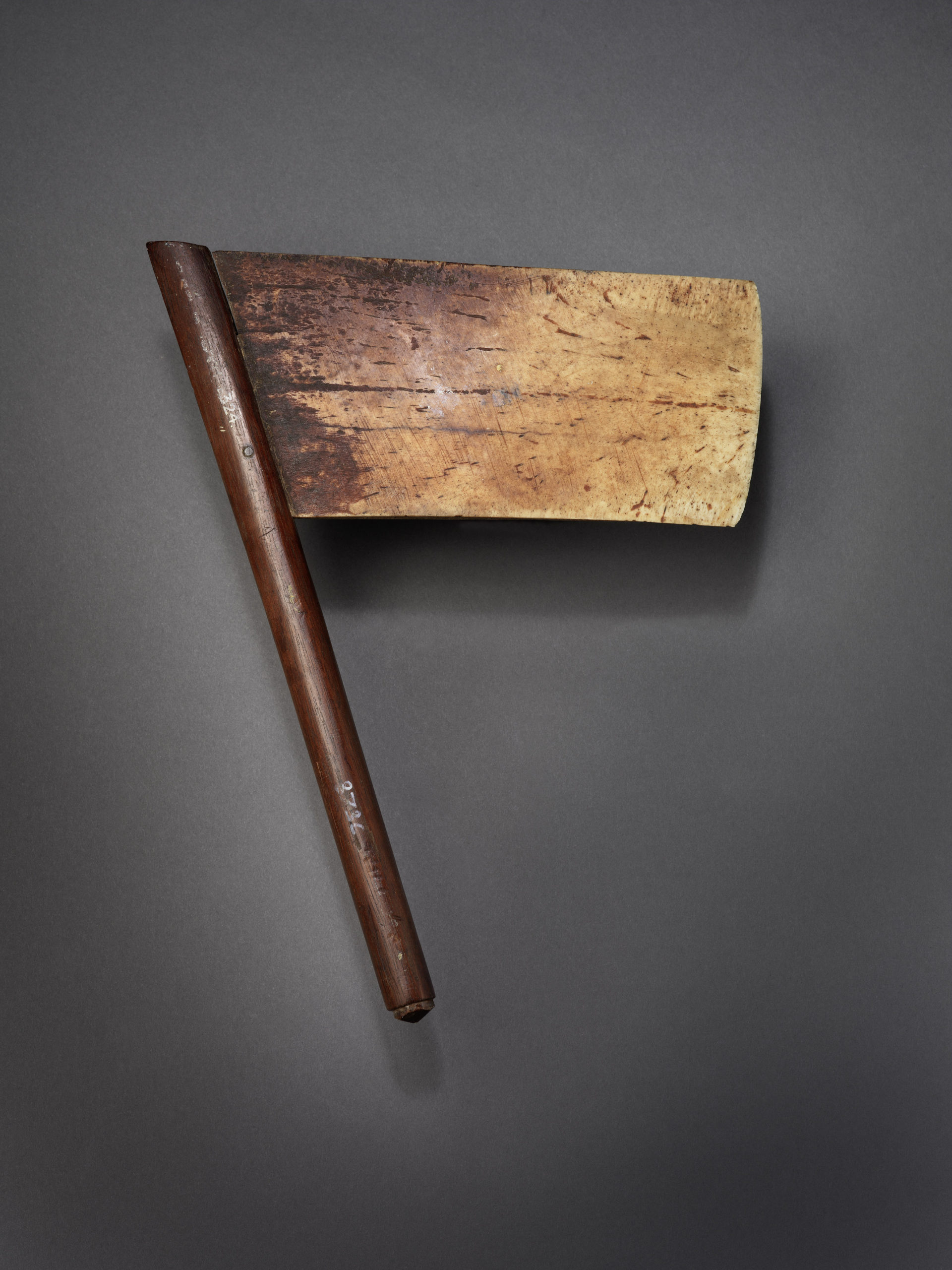Tigo
Désignation: Tigo
Pays: Wuvulu, formerly Matty Island, Archipel Bismarck
Date: 19th century
Taille: 27,5 cm, 10 5/8 in
Description: A breadfruit tree axe, Tigo, made of wood and tortoise bone. Wuvulu, formerly Matty Island, Archipel Bismarck
Provenance :
Collection William Downing Webster (1863-1913), Londres / Bicester
Augustus H. Lane Pitt Rivers (1827-1900), Farnham
Pitt Rivers Museum, Farnham (inv. n° 324.8736)
Collection Nelly Van den Abbeele, Bruxelles / Amsterdam
Christie’s, Amsterdam, Important Oceanic art from the Collection of Mrs. Nelly Van den Abbeele, 6 décembre 1999, n° 525
Collection Udo et Wally Horstmann, Zug, acquis lors de cette vente
Collection privée européenne
(inscription manuscrite : "Matty Island Bone Axe. BT Webster. May 1897. P")
References :
Cross-cultural interaction on Wuvulu Island, Papua New Guinea, Journal of Archaeological Science, Kononenko, Torrence, Barton and Hennell, 2009
Wuvulu is a coral atoll located 150 km north of the New Guinea mainland. Wuvulu and its neighboring islands were the scene of a collecting frenzy by Germans. Bismarck Archipelago and the northern Solomon Islands became a German protectorate in 1885 and was the first part of the German colonial empire.
Initially, objects collected on Wuvulu as part of a trip to search for plantation laborers were sent to the Berlin Museum. The ethnology curator, Felix von Luschan, was fascinated because he noticed that the particular forms and styles of the Wuvulu objects, particularly turtle bone cleavers were very similar to those from the Micronesian islands to the north rather than those of their closest neighbors in New Guinea. He therefore suspected the material culture might reflect a history of migration in the region.
The cleavers are called « vigo » on Wuvulu and « tawe », « tigo » on Aua islands next door. Amateur ethnographer Parkinson states that the tools were used to divide up a mass of pulped breadfruit or swamp taro as part of food preparation. A cutting action seems most likely since the blade is hafted parallel to the shaft, as for an axe.
Provenance :
Collection William Downing Webster (1863-1913), Londres / Bicester
Augustus H. Lane Pitt Rivers (1827-1900), Farnham
Pitt Rivers Museum, Farnham (inv. n° 324.8736)
Collection Nelly Van den Abbeele, Bruxelles / Amsterdam
Christie’s, Amsterdam, Important Oceanic art from the Collection of Mrs. Nelly Van den Abbeele, 6 décembre 1999, n° 525
Collection Udo et Wally Horstmann, Zug, acquis lors de cette vente
Collection privée européenne
(inscription manuscrite : "Matty Island Bone Axe. BT Webster. May 1897. P")
References :
Cross-cultural interaction on Wuvulu Island, Papua New Guinea, Journal of Archaeological Science, Kononenko, Torrence, Barton and Hennell, 2009
Wuvulu is a coral atoll located 150 km north of the New Guinea mainland. Wuvulu and its neighboring islands were the scene of a collecting frenzy by Germans. Bismarck Archipelago and the northern Solomon Islands became a German protectorate in 1885 and was the first part of the German colonial empire.
Initially, objects collected on Wuvulu as part of a trip to search for plantation laborers were sent to the Berlin Museum. The ethnology curator, Felix von Luschan, was fascinated because he noticed that the particular forms and styles of the Wuvulu objects, particularly turtle bone cleavers were very similar to those from the Micronesian islands to the north rather than those of their closest neighbors in New Guinea. He therefore suspected the material culture might reflect a history of migration in the region.
The cleavers are called « vigo » on Wuvulu and « tawe », « tigo » on Aua islands next door. Amateur ethnographer Parkinson states that the tools were used to divide up a mass of pulped breadfruit or swamp taro as part of food preparation. A cutting action seems most likely since the blade is hafted parallel to the shaft, as for an axe.
